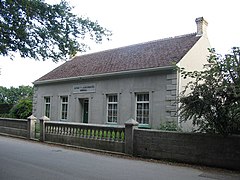Luxulyan
Luxulyan
|
|
|---|---|
 Luxulyan Institute |
|
| Luxulyan shown within Cornwall | |
| Population | 1,381 (Civil Parish, 2011 including Bodwen , Bridges and Lockengate) |
| OS grid reference | SX051581 |
| Civil parish |
|
| Unitary authority | |
| Ceremonial county | |
| Region | |
| Country | England |
| Sovereign state | United Kingdom |
| Post town | BODMIN |
| Postcode district | PL30 |
| Dialling code | 01726 |
| Police | Devon and Cornwall |
| Fire | Cornwall |
| Ambulance | South Western |
| EU Parliament | South West England |
| UK Parliament | |
Luxulyan (/ləkˈsɪljən/; Cornish: Logsulyan), also spelt Luxullian or Luxulian, is a village and civil parish in mid Cornwall, England, United Kingdom. The village lies four miles (6.5 km) northeast of St Austell and six miles (10 km) south of Bodmin. The population of the parish was 1,371 in the 2001 census. This had risen to 1,381 at the 2011 census.
Luxulyan parish lies in an area of china clay quarries on the St Austell granite batholith (see also Geology of Cornwall) and numerous small granite domes are dotted around the parish. Luxulyan Quarry, a designated Site of Special Scientific Interest to the north of the village, exposes examples of this rock.
Luxulyanite, a rare type of Cornish granite (named after the village) is found in the area and was used for the Duke of Wellington's sarcophagus in St Paul's Cathedral.
Luxulyan is best known for Luxulyan Valley, a steep sided and thickly wooded stretch of the valley of the River Par that contains a major concentration of early 19th century industrial remains, including a combined Aqueduct and Viaduct. The valley was designated a World Heritage Site in 2006.
...
Wikipedia

